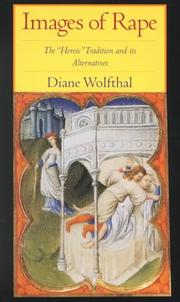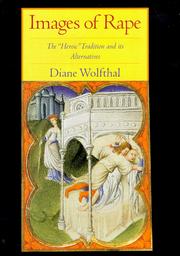| Listing 1 - 5 of 5 |
Sort by
|

ISBN: 0521794420 9780521794428 Year: 1999 Publisher: Cambridge: Cambridge university press,
Abstract | Keywords | Export | Availability | Bookmark
 Loading...
Loading...Choose an application
- Reference Manager
- EndNote
- RefWorks (Direct export to RefWorks)
This book is the first-in-depth exploration of rape as it has been portrayed in Western art from the twelfth through seventeenth centuries. Examining the full range of representations, from those that glorify rape to those that condemn it, Diane Wolfthal illuminates the complex web of attitudes towards sexual violence that existed in the medieval and early modern society. Wolfthal first explores Italian Renaissance and Baroque images of "heroic" rape, in which the victim seldom suffers and the crime is sanitized, aestheticized, or eroticized. These are contrasted with a range of images, mostly created in Northern Europe, that have been ignored. Often critical of the assailant and sympathetic to his victim, these works reveal that society did, in certain circumstances, severely condemn the act of rape. Using picture bibles, law treatises, justice paintings, war prints, and the manuscripts of Christine de Pizan, among other visual documentation, Wolfthal demonstrates how this range of images still influences contemporary debate about sexual violence.
Iconography --- raping --- Rape in art --- Rape --- History --- Rape in art - History --- Rape - Europe - History --- vrouwengeschiedenis
Book
ISBN: 9061942861 Year: 1988 Publisher: Utrecht Hes Uitgevers
Abstract | Keywords | Export | Availability | Bookmark
 Loading...
Loading...Choose an application
- Reference Manager
- EndNote
- RefWorks (Direct export to RefWorks)
Rape in art --- Rape in art. --- Arts. --- Criminology. Victimology --- Sociology of the family. Sociology of sexuality --- Arts --- Arts, Fine --- Arts, Occidental --- Arts, Western --- Fine arts --- Humanities --- Arts, Primitive --- Sexually transgressive behavior --- Rape --- Book --- Culture
Book
Year: 1982 Publisher: Zürich : Die Sammlung,
Abstract | Keywords | Export | Availability | Bookmark
 Loading...
Loading...Choose an application
- Reference Manager
- EndNote
- RefWorks (Direct export to RefWorks)
Prints, Dutch --- Prints, Flemish --- Mannerism (Art) --- Love in art --- Rape in art --- Estampe néerlandaise --- Estampe flamande --- Maniérisme (Art) --- Amour dans l'art --- Viol dans l'art --- Exhibitions. --- Expositions --- Goltzius, Hendrik, --- Influence

ISBN: 052158311X Year: 1999 Publisher: Cambridge : Cambridge university press,
Abstract | Keywords | Export | Availability | Bookmark
 Loading...
Loading...Choose an application
- Reference Manager
- EndNote
- RefWorks (Direct export to RefWorks)
The first in-depth exploration of rape as it has been portrayed in Western art from the twelfth through seventeenth centuries. Examining the full range of representations, from those that glorify rape to those that condemn it, Diane Wolfthal illuminates the complex web of attitudes towards sexual violence that existed in the medieval and early modern society. Wolfthal first explores Italian Renaissance and Baroque images of 'heroic' rape, in which the victim seldom suffers and the crime is sanitized, aestheticized, or eroticized. These are contrasted with a range of images, mostly created in Northern Europe, that have been ignored. Often critical of the assailant and sympathetic to his victim, these works reveal that society did, in certain circumstances, severely condemn the act of rape. Wolfthal demonstrates how this range of images still influences contemporary debate about sexual violence. Winner of the Sierra Prize, Western Association of Women Historians in the year 2000
Iconography --- anno 500-1499 --- anno 1600-1699 --- anno 1500-1599 --- Art [Baroque ] --- Art [Medieval ] --- Art [Renaissance ] --- Art baroque --- Art de la Renaissance --- Art médiéval --- Barok in de kunst --- Barokkunst --- Baroque art --- Baroque dans l'art --- Kunst [Barok] --- Kunst [Middeleeuwse ] --- Kunst [Renaissance] --- Medieval art --- Middeleeuwse kunst --- Rape in art --- Renaissance art --- Renaissancekunst --- Verkrachting in de kunst --- Viol dans l'art --- Rape in art. --- Art, Medieval. --- Art, Renaissance. --- Art, Baroque. --- Art médiéval
Book
ISBN: 1009302299 1009122525 1009302302 1009100688 Year: 2023 Publisher: Cambridge : Cambridge University Press,
Abstract | Keywords | Export | Availability | Bookmark
 Loading...
Loading...Choose an application
- Reference Manager
- EndNote
- RefWorks (Direct export to RefWorks)
This book is the first comprehensive study of images of rape in Italian painting at the dawn of the Renaissance. Drawing on a wide range of primary sources, P{copy}{flat}ter Bokody examines depictions of sexual violence in religion, law, medicine, literature, politics, and history writing produced in kingdoms (Sicily and Naples) and city-republics (Florence, Siena, Lucca, Bologna and Padua). Whilst misogynistic endorsement characterized many of these visual discourses, some urban communities condemned rape in their propaganda against tyranny. Such representations of rape often link gender and aggression to war, abduction, sodomy, prostitution, pregnancy, and suicide. Bokody also traces how the new naturalism in painting, introduced by Giotto, increased verisimilitude, but also fostered imagery that coupled eroticism and violation. Exploring images and texts that have long been overlooked, Bokody's study provides new insights at the intersection of gender, policy, and visual culture, with evident relevance to our contemporary condition.
Rape in art. --- Sex crimes in art. --- Painting, Italian --- Themes, motives. --- Italian painting --- Painting, Renaissance --- Art --- Art and society --- Political aspects --- History --- Art and sociology --- Society and art --- Sociology and art --- Art, Occidental --- Art, Primitive --- Art, Visual --- Art, Western (Western countries) --- Arts, Fine --- Arts, Visual --- Fine arts --- Iconography --- Occidental art --- Visual arts --- Western art (Western countries) --- Arts --- Aesthetics --- Paintings, Renaissance --- Renaissance painting --- Social aspects
| Listing 1 - 5 of 5 |
Sort by
|

 Search
Search Feedback
Feedback About UniCat
About UniCat  Help
Help News
News